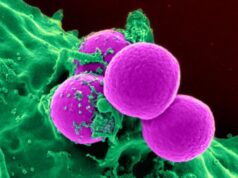By removing the protein galectin-3 (Gal3), a team of investigators led by University of California School of Medicine researchers were able to reverse diabetic insulin resistance and glucose intolerance in mouse models of obesity and diabetes.
By binding to insulin receptors on cells, Gal3 prevents insulin from attaching to the receptors resulting in cellular insulin resistance. The team led by Jerrold Olefsky, MD, professor of medicine in the Division of Endocrinology and Metabolism at UC San Diego School of Medicine, showed that by genetically removing Gal3 or using pharmaceutical inhibitors to target it, insulin sensitivity and glucose tolerance could be returned to normal, even among older mice. However, obesity remained unchanged.
“This study puts Gal3 on the map for insulin resistance and diabetes in mouse model,” said Olefsky, associate dean for scientific affairs and senior author of the study. “Our findings suggest that Gal3 inhibition in people could be an effective anti-diabetic approach.”
Olefsky and other researchers have been studying how chronic tissue inflammation leads to insulin resistance in type 2 diabetes. In the paper, published in the journal Cell on November 3, researchers explain that inflammation requires macrophages — specialized cells that destroy targeted cells. In obese adipose tissue (fat), for example, 40 percent of cells are macrophages. Macrophages in turn secrete Gal3, which then acts as a signaling protein attracting more macrophages, thus resulting in the production of even more Gal3.
Furthermore, investigators identified bone marrow-derived macrophages as the source of Gal3 that leads to insulin resistance. More importantly, researchers found that Gal3 is secreted by macrophages, and can then cause insulin resistance in liver, fat cells, and muscle cells independent of inflammation.
Gal3 has previously been connected to other diseases. Olefsky will continue to study Gal3 depletion as a possible therapeutic target for nonalcoholic steatohepatitis as well as heart and liver fibrosis.
Find your dream job in the space industry. Check our Space Job Board »
Study co-authors include: Pingping Li, Chinese Academy of Medical Sciences, Peking Union Medical College and UC San Diego; Shuainan Liu, Zhufang Shen, Bing Cui, Lijuan Kong, Shaocong Hou, Xiao Liang, Chinese Academy of Medical Sciences, Peking Union Medical College; Min Lu, UC San Diego, and Merck Research Laboratories; Gautum Bandyyopadhyay, Dayoung Oh, Andrew M. Johnson, Dorothy Sears, Wei Ying, Olivia Osborn, Joshua Wollam, UC San Diego; Takeshi Imamura, Shiga University of Medical Science; Salvatore Iovino, Martin Brenner, Merck Research Laboratories; Steven M. Watkins, Lipomics Technologies, Inc.
This research was funded, in part, by grants from the National Institutes of Health (DK033651, DK074868, DK063491, DK09062) and Merck (LKR159915).
Source: University of California San Diego Health Sciences
Journal Reference:
- Pingping Li, Shuainan Liu, Min Lu, Gautum Bandyopadhyay, Dayoung Oh, Takeshi Imamura, Andrew M.F. Johnson, Dorothy Sears, Zhufang Shen, Bing Cui, Lijuan Kong, Shaocong Hou, Xiao Liang, Salvatore Iovino, Steven M. Watkins, Wei Ying, Olivia Osborn, Joshua Wollam, Martin Brenner, Jerrold M. Olefsky. Hematopoietic-Derived Galectin-3 Causes Cellular and Systemic Insulin Resistance. Cell, 2016; 167 (4): 973 DOI: 10.1016/j.cell.2016.10.025










